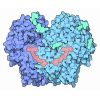[English] 日本語
 Yorodumi
Yorodumi- PDB-1dan: Complex of active site inhibited human blood coagulation factor V... -
+ Open data
Open data
- Basic information
Basic information
| Entry | Database: PDB / ID: 1dan | ||||||
|---|---|---|---|---|---|---|---|
| Title | Complex of active site inhibited human blood coagulation factor VIIA with human recombinant soluble tissue factor | ||||||
 Components Components |
| ||||||
 Keywords Keywords | HYDROLASE/HYDROLASE INHIBITOR /  BLOOD COAGULATION / BLOOD COAGULATION /  SERINE PROTEASE / SERINE PROTEASE /  CO-FACTOR / RECEPTOR ENZYME / GLA / EGF / HYDROLASE-HYDROLASE INHIBITOR COMPLEX CO-FACTOR / RECEPTOR ENZYME / GLA / EGF / HYDROLASE-HYDROLASE INHIBITOR COMPLEX | ||||||
| Function / homology |  Function and homology information Function and homology informationactivation of plasma proteins involved in acute inflammatory response / activation of blood coagulation via clotting cascade /  coagulation factor VIIa / response to Thyroid stimulating hormone / response to 2,3,7,8-tetrachlorodibenzodioxine / response to astaxanthin / response to thyrotropin-releasing hormone / response to genistein / serine-type peptidase complex / positive regulation of platelet-derived growth factor receptor signaling pathway ...activation of plasma proteins involved in acute inflammatory response / activation of blood coagulation via clotting cascade / coagulation factor VIIa / response to Thyroid stimulating hormone / response to 2,3,7,8-tetrachlorodibenzodioxine / response to astaxanthin / response to thyrotropin-releasing hormone / response to genistein / serine-type peptidase complex / positive regulation of platelet-derived growth factor receptor signaling pathway ...activation of plasma proteins involved in acute inflammatory response / activation of blood coagulation via clotting cascade /  coagulation factor VIIa / response to Thyroid stimulating hormone / response to 2,3,7,8-tetrachlorodibenzodioxine / response to astaxanthin / response to thyrotropin-releasing hormone / response to genistein / serine-type peptidase complex / positive regulation of platelet-derived growth factor receptor signaling pathway / response to vitamin K / response to carbon dioxide / response to thyroxine / positive regulation of leukocyte chemotaxis / NGF-stimulated transcription / response to cholesterol / response to growth hormone / coagulation factor VIIa / response to Thyroid stimulating hormone / response to 2,3,7,8-tetrachlorodibenzodioxine / response to astaxanthin / response to thyrotropin-releasing hormone / response to genistein / serine-type peptidase complex / positive regulation of platelet-derived growth factor receptor signaling pathway / response to vitamin K / response to carbon dioxide / response to thyroxine / positive regulation of leukocyte chemotaxis / NGF-stimulated transcription / response to cholesterol / response to growth hormone /  cytokine receptor activity / positive regulation of positive chemotaxis / Extrinsic Pathway of Fibrin Clot Formation / positive regulation of TOR signaling / animal organ regeneration / positive regulation of blood coagulation / Gamma-carboxylation of protein precursors / Transport of gamma-carboxylated protein precursors from the endoplasmic reticulum to the Golgi apparatus / Removal of aminoterminal propeptides from gamma-carboxylated proteins / positive regulation of endothelial cell proliferation / serine-type peptidase activity / BMAL1:CLOCK,NPAS2 activates circadian gene expression / positive regulation of interleukin-8 production / cytokine receptor activity / positive regulation of positive chemotaxis / Extrinsic Pathway of Fibrin Clot Formation / positive regulation of TOR signaling / animal organ regeneration / positive regulation of blood coagulation / Gamma-carboxylation of protein precursors / Transport of gamma-carboxylated protein precursors from the endoplasmic reticulum to the Golgi apparatus / Removal of aminoterminal propeptides from gamma-carboxylated proteins / positive regulation of endothelial cell proliferation / serine-type peptidase activity / BMAL1:CLOCK,NPAS2 activates circadian gene expression / positive regulation of interleukin-8 production /  phospholipid binding / protein processing / Golgi lumen / cytokine-mediated signaling pathway / phospholipid binding / protein processing / Golgi lumen / cytokine-mediated signaling pathway /  circadian rhythm / response to estrogen / activation of cysteine-type endopeptidase activity involved in apoptotic process / positive regulation of angiogenesis / circadian rhythm / response to estrogen / activation of cysteine-type endopeptidase activity involved in apoptotic process / positive regulation of angiogenesis /  blood coagulation / response to estradiol / collagen-containing extracellular matrix / blood coagulation / response to estradiol / collagen-containing extracellular matrix /  protease binding / vesicle / response to hypoxia / positive regulation of cell migration / protease binding / vesicle / response to hypoxia / positive regulation of cell migration /  endoplasmic reticulum lumen / external side of plasma membrane / endoplasmic reticulum lumen / external side of plasma membrane /  signaling receptor binding / serine-type endopeptidase activity / signaling receptor binding / serine-type endopeptidase activity /  calcium ion binding / positive regulation of gene expression / calcium ion binding / positive regulation of gene expression /  cell surface / cell surface /  extracellular space / extracellular region / extracellular space / extracellular region /  membrane / membrane /  plasma membrane plasma membraneSimilarity search - Function | ||||||
| Biological species |   Homo sapiens (human) Homo sapiens (human) | ||||||
| Method |  X-RAY DIFFRACTION / X-RAY DIFFRACTION /  SYNCHROTRON / Resolution: 2 Å SYNCHROTRON / Resolution: 2 Å | ||||||
 Authors Authors | Banner, D.W. | ||||||
 Citation Citation |  Journal: Nature / Year: 1996 Journal: Nature / Year: 1996Title: The crystal structure of the complex of blood coagulation factor VIIa with soluble tissue factor. Authors: Banner, D.W. / D'Arcy, A. / Chene, C. / Winkler, F.K. / Guha, A. / Konigsberg, W.H. / Nemerson, Y. / Kirchhofer, D. | ||||||
| History |
|
- Structure visualization
Structure visualization
| Structure viewer | Molecule:  Molmil Molmil Jmol/JSmol Jmol/JSmol |
|---|
- Downloads & links
Downloads & links
- Download
Download
| PDBx/mmCIF format |  1dan.cif.gz 1dan.cif.gz | 137.4 KB | Display |  PDBx/mmCIF format PDBx/mmCIF format |
|---|---|---|---|---|
| PDB format |  pdb1dan.ent.gz pdb1dan.ent.gz | 109.2 KB | Display |  PDB format PDB format |
| PDBx/mmJSON format |  1dan.json.gz 1dan.json.gz | Tree view |  PDBx/mmJSON format PDBx/mmJSON format | |
| Others |  Other downloads Other downloads |
-Validation report
| Arichive directory |  https://data.pdbj.org/pub/pdb/validation_reports/da/1dan https://data.pdbj.org/pub/pdb/validation_reports/da/1dan ftp://data.pdbj.org/pub/pdb/validation_reports/da/1dan ftp://data.pdbj.org/pub/pdb/validation_reports/da/1dan | HTTPS FTP |
|---|
-Related structure data
| Similar structure data |
|---|
- Links
Links
- Assembly
Assembly
| Deposited unit | 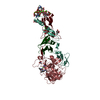
| ||||||||
|---|---|---|---|---|---|---|---|---|---|
| 1 |
| ||||||||
| Unit cell |
|
- Components
Components
-BLOOD COAGULATION FACTOR VIIA ... , 2 types, 2 molecules LH
| #1: Protein | Mass: 17487.076 Da / Num. of mol.: 1 Source method: isolated from a genetically manipulated source Source: (gene. exp.)   Homo sapiens (human) / Cell line: BABY HAMSTER KIDNEY CELLS / Organ: BLOOD Homo sapiens (human) / Cell line: BABY HAMSTER KIDNEY CELLS / Organ: BLOOD / Cell line (production host): BHK CELLS / Production host: / Cell line (production host): BHK CELLS / Production host:   Mesocricetus auratus (golden hamster) / References: UniProt: P08709, Mesocricetus auratus (golden hamster) / References: UniProt: P08709,  coagulation factor VIIa coagulation factor VIIa |
|---|---|
| #2: Protein | Mass: 28103.256 Da / Num. of mol.: 1 Source method: isolated from a genetically manipulated source Source: (gene. exp.)   Homo sapiens (human) / Cell line: BABY HAMSTER KIDNEY CELLS / Organ: BLOOD Homo sapiens (human) / Cell line: BABY HAMSTER KIDNEY CELLS / Organ: BLOOD / Cell line (production host): BHK CELLS / Production host: / Cell line (production host): BHK CELLS / Production host:   Mesocricetus auratus (golden hamster) / References: UniProt: P08709, Mesocricetus auratus (golden hamster) / References: UniProt: P08709,  coagulation factor VIIa coagulation factor VIIa |
-SOLUBLE TISSUE ... , 2 types, 2 molecules TU
| #3: Protein | Mass: 9229.303 Da / Num. of mol.: 1 Source method: isolated from a genetically manipulated source Source: (gene. exp.)   Homo sapiens (human) / Cell line: BABY HAMSTER KIDNEY CELLS / Organ: BLOOD Homo sapiens (human) / Cell line: BABY HAMSTER KIDNEY CELLS / Organ: BLOOD / Production host: / Production host:   Escherichia coli (E. coli) / References: UniProt: P13726 Escherichia coli (E. coli) / References: UniProt: P13726 |
|---|---|
| #4: Protein | Mass: 13802.352 Da / Num. of mol.: 1 Source method: isolated from a genetically manipulated source Source: (gene. exp.)   Homo sapiens (human) / Cell line: BABY HAMSTER KIDNEY CELLS / Organ: BLOOD Homo sapiens (human) / Cell line: BABY HAMSTER KIDNEY CELLS / Organ: BLOOD / Production host: / Production host:   Escherichia coli (E. coli) / References: UniProt: P13726 Escherichia coli (E. coli) / References: UniProt: P13726 |
-Sugars , 2 types, 2 molecules 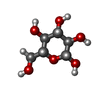
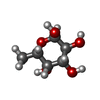

| #5: Sugar | ChemComp-BGC /  Glucose Glucose |
|---|---|
| #6: Sugar | ChemComp-FUC /  Fucose Fucose |
-Non-polymers , 5 types, 251 molecules 
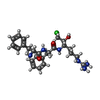
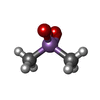






| #7: Chemical | ChemComp-CA / #8: Chemical | ChemComp-0Z6 / | #9: Chemical | ChemComp-CAC / |  Cacodylic acid Cacodylic acid#10: Chemical | ChemComp-CL / |  Chloride Chloride#11: Water | ChemComp-HOH / |  Water Water |
|---|
-Details
| Nonpolymer details | THE INHIBITOR IS BOUND TO THE ACTIVE SITE OF THE ENZYME. THE UNBOUND FORM OF THE INHIBITOR IS D-PHE- ...THE INHIBITOR IS BOUND TO THE ACTIVE SITE OF THE ENZYME. THE UNBOUND FORM OF THE INHIBITOR IS D-PHE-PHE-ARG-CHLOROMETH |
|---|
-Experimental details
-Experiment
| Experiment | Method:  X-RAY DIFFRACTION X-RAY DIFFRACTION |
|---|
- Sample preparation
Sample preparation
| Crystal | Density Matthews: 2.67 Å3/Da / Density % sol: 53.91 % |
|---|---|
Crystal grow | *PLUS Method: sparse matrix screen |
| Components of the solutions | *PLUS Conc.: 10 mg/ml / Common name: Sephacryl S-200 column |
-Data collection
| Diffraction source | Source:  SYNCHROTRON / Site: SYNCHROTRON / Site:  SRS SRS  / Beamline: PX9.5 / Wavelength: 0.89 / Beamline: PX9.5 / Wavelength: 0.89 |
|---|---|
| Detector | Type: MARRESEARCH / Detector: IMAGE PLATE |
| Radiation | Scattering type: x-ray |
| Radiation wavelength | Wavelength : 0.89 Å / Relative weight: 1 : 0.89 Å / Relative weight: 1 |
| Reflection | Highest resolution: 1.95 Å / Num. obs: 54736 / Biso Wilson estimate: 15.7 Å2 / Rmerge(I) obs: 0.076 / Net I/σ(I): 10.6 |
| Reflection | *PLUS Num. measured all: 162150 |
- Processing
Processing
| Software |
| ||||||||||||||||||||||||||||||||||||||||||||||||||||||||||||||||||||||||||||||||
|---|---|---|---|---|---|---|---|---|---|---|---|---|---|---|---|---|---|---|---|---|---|---|---|---|---|---|---|---|---|---|---|---|---|---|---|---|---|---|---|---|---|---|---|---|---|---|---|---|---|---|---|---|---|---|---|---|---|---|---|---|---|---|---|---|---|---|---|---|---|---|---|---|---|---|---|---|---|---|---|---|---|
| Refinement | Resolution: 2→20 Å / Rfactor Rfree error: 0.003 / Data cutoff high absF: 10000000 / Data cutoff low absF: 0.001 / Isotropic thermal model: RESTRAINED / Cross valid method: A POSTERIORI / σ(F): 0 / Details: BULK SOLVENT MODEL USED
| ||||||||||||||||||||||||||||||||||||||||||||||||||||||||||||||||||||||||||||||||
| Displacement parameters | Biso mean: 33.2 Å2
| ||||||||||||||||||||||||||||||||||||||||||||||||||||||||||||||||||||||||||||||||
| Refine analyze |
| ||||||||||||||||||||||||||||||||||||||||||||||||||||||||||||||||||||||||||||||||
| Refinement step | Cycle: LAST / Resolution: 2→20 Å
| ||||||||||||||||||||||||||||||||||||||||||||||||||||||||||||||||||||||||||||||||
| Refine LS restraints |
| ||||||||||||||||||||||||||||||||||||||||||||||||||||||||||||||||||||||||||||||||
| LS refinement shell | Resolution: 2→2.07 Å / Rfactor Rfree error: 0.014 / Total num. of bins used: 10
| ||||||||||||||||||||||||||||||||||||||||||||||||||||||||||||||||||||||||||||||||
| Xplor file |
| ||||||||||||||||||||||||||||||||||||||||||||||||||||||||||||||||||||||||||||||||
| Software | *PLUS Name:  X-PLOR / Classification: refinement X-PLOR / Classification: refinement | ||||||||||||||||||||||||||||||||||||||||||||||||||||||||||||||||||||||||||||||||
| Refinement | *PLUS | ||||||||||||||||||||||||||||||||||||||||||||||||||||||||||||||||||||||||||||||||
| Solvent computation | *PLUS | ||||||||||||||||||||||||||||||||||||||||||||||||||||||||||||||||||||||||||||||||
| Displacement parameters | *PLUS | ||||||||||||||||||||||||||||||||||||||||||||||||||||||||||||||||||||||||||||||||
| Refine LS restraints | *PLUS
| ||||||||||||||||||||||||||||||||||||||||||||||||||||||||||||||||||||||||||||||||
| LS refinement shell | *PLUS Rfactor obs: 0.278 |
 Movie
Movie Controller
Controller


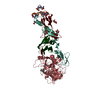
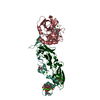
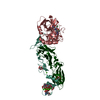
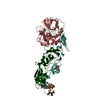
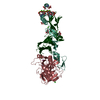

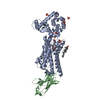
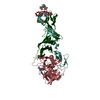
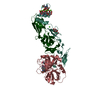
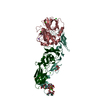
 PDBj
PDBj









